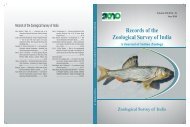Vol. 111 - Part I - Zoological Survey of India
Vol. 111 - Part I - Zoological Survey of India
Vol. 111 - Part I - Zoological Survey of India
You also want an ePaper? Increase the reach of your titles
YUMPU automatically turns print PDFs into web optimized ePapers that Google loves.
Rec. zool. Surv. <strong>India</strong> : <strong>111</strong>(<strong>Part</strong>–1) : 71-76, 2011<br />
ORTHOPTERA OF VAN VIHAR NATIONAL PARK, MADHYA PRADESH (INDIA)<br />
INTRODUCTION<br />
Van Vihar National Park (VVNP) is situated in Bhopal<br />
city with an area <strong>of</strong> 445.21 hectare. The area lies between<br />
latitudes 22° 47´´ to 23º 33´´ N and longitudes 77º 21´´<br />
to 78º 49´´ E. VVNP is developed and managed as a<br />
modern <strong>Zoological</strong> Park as per the guidelines <strong>of</strong> the<br />
Central Zoo Authority.<br />
Vegetation is <strong>of</strong> southern tropical dry deciduous<br />
scrub forests, consisting <strong>of</strong> major trees like saja, bel,<br />
amaltas, babool, doodhi, lendia, amla and tendu etc.<br />
Many herbivores and carnivores are housed in the<br />
confines <strong>of</strong> Van Vihar. Carnivores like tiger, leopard,<br />
hyena, jungle cat and sloth bear, and herbivores like<br />
nilgai, chital, sambar are kept in large enclosures. The<br />
area serves as the green lung for Bhopal city.<br />
Little information is available on the Orthopteran<br />
fauna <strong>of</strong> the National parks even though 94 species<br />
were reported from the state (Kirby, 1914, Chopard, 1969<br />
and Chandra et al., 2007. The present record <strong>of</strong> 16<br />
species <strong>of</strong> Orthoptera acommodated under 16 genus<br />
belonging to 5 families from the first report <strong>of</strong> the group<br />
from this national Park.<br />
SYSTEMATIC ACCOUNT<br />
Order ORTHOPTERA<br />
Suborder CAELIFERA<br />
Infraorder ACRIDIDEA<br />
Superfamily ACRIDOIDEA<br />
Family ACRIDIDAE<br />
Subfamily ACRIDINAE<br />
Genus Acrida Linnaeus, 1758<br />
1. Acrida exaltata (Walker)<br />
1859. Truxalis exaltata Walker, Ann. Mag. nat. Hist., 4(3) :<br />
222.<br />
SUNIL KUMAR GUPTA AND KAILASH CHANDRA<br />
Central Regional Station, <strong>Zoological</strong> <strong>Survey</strong> <strong>of</strong> <strong>India</strong><br />
Vijay Nagar, Jabalpur-482002<br />
Key-words : Orthoptera, Van Vihar National Park, Madhya Pradesh, <strong>India</strong>.<br />
1954. Acrida exaltata, Dirsh, Bull. Soc. Fouad Ent., 38 : 149.<br />
Material examined : Bhopal; VVNP, Vihar vithika,<br />
12.x.2003(1♂), 16.x.2003(1♀), 17.x.2003 (2♀); Gate no. 1<br />
& 2, 14.x.2003 (1♀); coll. Dinesh Nema & S. Ahirwar.<br />
Diagnostic characters : Head conically ascending,<br />
basal part narrow; fastigium <strong>of</strong> vertex broad, laminate<br />
and truncate at extremity; transverse sulcus <strong>of</strong> pronotum<br />
placed near middle <strong>of</strong> disc; male sub genital plate<br />
elongate; tegmina without pointed apex, a little<br />
produced beyond the hind knees; wings slightly shorter<br />
than tegmina.<br />
Distribution : <strong>India</strong> : Andhra Pradesh, Arunachal<br />
Pradesh, Assam, Bihar, Chhattisgarh, Goa, Gujarat,<br />
Himachal Pradesh, Jammu & Kashmir, Karnataka, Kerala,<br />
Madhya Pradesh, Maharashtra, Manipur, Orissa,<br />
Rajasthan, Sikkim, Tamil Nadu, Tripura, Uttar Pradesh<br />
and West Bengal. Elsewhere: Afghanistan, Bangladesh,<br />
Iran, Pakistan, Saudi Arabia, Sri Lanka, Yemen and West<br />
Aden.<br />
Genus Ceracris Walker, 1870<br />
2. Ceracris nigricornis Walker<br />
1870. Ceracris nigricornis Walker, Cat. Derm. Salt. Brit.<br />
Mus., 4 : 791.<br />
1914. Ceracris nigricornis : Kirby, Fauna Brit. <strong>India</strong>, Orth.,:<br />
110.<br />
Material examined : Bhopal ; VVNP, 15.x.2003 (1♂),<br />
coll. Dinesh Nema & S. Ahirwar.<br />
Diagnostic characters : Body colour testaceusbrown;<br />
head rugosely punctuate, slightly convex above,<br />
with a dusky longitudinal curved depression on each<br />
side, but without distinct carina behind the eyes; a<br />
black band behind each eye followed by a black line
















